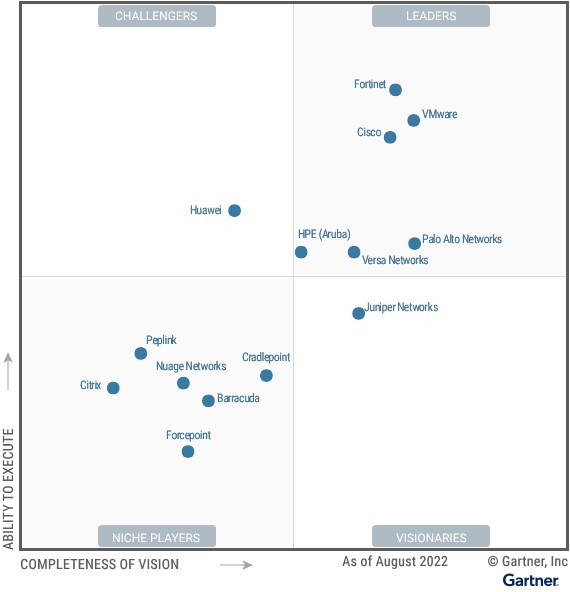Gartner came out with its annual SD-WAN magic quadrant last week. I agree with their placements and predict that, in the coming years, the field will narrow from six vendors to four.
An SD-WAN solution is a long-term investment that takes years to implement, so selecting a vendor can feel like placing a big bet. Gone are the days when Cisco had a monopoly, and you could take a Cisco router, have it directly connected, and work with a Juniper or other vendor’s routers. In the SD-WAN world, an SD-WAN router from one vendor cannot talk to another vendor. Even within Cisco, their Meraki SD-WAN solution cannot interconnect with their Viptela solution. SD-WAN is a proprietary technology that will never have an IETF protocol standard. Once an enterprise chooses a vendor, it is hard to go back.
My keys to predicting where the SD-WAN market will be in three years are based on the following:
- Security-first, to the edge strategy. Security is the top network requirement over and above costs, performance, and management. Cyber-insurance and board-level interest are driving enterprises to ensure that they’re putting in market leading solutions. The second is that security starts at the very edge of the network. Local and WAN segmentation with Unified threat management (UTM) protection is key to identifying and containing malicious traffic in near real-time.
- Client-to-cloud integration for end-to-end network security and performance. End-to-end means a proprietary solution that can encrypt and control the traffic and use artificial intelligence (AI) and machine learning (ML) to detect performance and security anomalies. The lack of interoperability of SD-WAN, security, and management functions means that organizations have to bet on a single vendor to get the most out of their investments. A best of breed vendor strategy from access to WAN distribution, into data-center and cloud cores is no longer viable, since network solutions are no longer following industry standards.
- Border Gateway Protocol (BGP) Support. Routing is critical to integrating today’s networks with tomorrow’s SD-WAN and multi-cloud networks. BGP is the best routing protocol to do this. All SD-WAN vendors use open source routing as part of their solutions, and some vendors have done a better job enhancing BGP and making it available via a command-line interface than others. Managing overlay and underlay routing tables is tricky.
- Go big or go home. Niche vendors do not have the resources to build, sell, implement, and support large networks unique to every enterprise. In 2015, there were more than 60 SD-WAN vendors. The number is down to 30. I predict the market will continue to contract to less than 10 viable vendors in three years.
I predict the top four SD-WAN Market Leaders in three years will be the following:
- Fortinet – They offer a very solid firewall, an SD-WAN solution already integrated in to their firewall platform, and a push to provide a leading solution from the client—all the way to the cloud. Fortinet is very cost-effective, and bundles in (for virtually free) SD-WAN with its firewall offering. The company just released their first generation AI/ML solution.
- Palo Alto – This leading firewall vendor purchased CloudGenix to get into the SD-WAN market. Palo Alto still has a couple years of work to build a fully integrated end-to-end solution. Good BGP routing support will be key in their ability to integrate existing networks with new and cloud networks.
- Cisco – The company invested a lot in getting its Viptela acquisition integrated and leveraging its strong base to migrate. Cisco is trying to marry its feature-rich platforms with its simple Meraki cloud management. Unfortunately, the company will continue to be challenged by complexity in a fully integrated end-to-end solution while not being a leading firewall vendor.
- Juniper – This company has all the ingredients to be a leader but needs to put it all together . Mavis, Juniper’s AI engine on its access solutions, is very impressive, plus the acquisition of 128 Technology with session-smart routing, plus an end-to-end product portfolio including security, has the potential to compete with the other leaders.
Betting on the right vendor is not only important to an enterprise but also for those network managers, architects, engineers, and support staff. There is a 25-40% compensation premium to the training and experience with leading-edge solutions. The one thing that we do know is that being a leader today does not guarantee leadership in three years. Who are you going to bet on and why?











